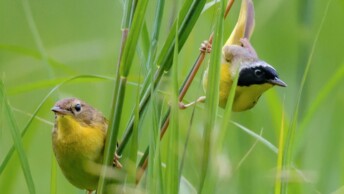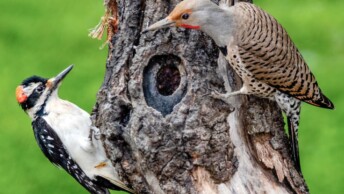Owls are some of the most fascinating and mysterious birds in Nevada, capturing the imagination with their haunting calls and silent flight. Found in a variety of habitats across the state, from dense forests to open deserts, these nocturnal hunters play a vital role in the ecosystem, controlling rodent populations and adding a touch of intrigue to the Nevada night.
With their sharp talons, piercing eyes, and uncanny ability to turn their heads almost completely around, owls are built for survival. Nevada is home to a surprising diversity of owl species, from the iconic Great Horned Owl to the elusive Barn Owl and even the tiny Burrowing Owl, which can sometimes be spotted during the day. Whether you’re hiking in the mountains, exploring desert trails, or even sitting in your backyard, you might hear their distinct calls or catch a fleeting glimpse of their shadowy forms.
This article will explore the types of owls you can find in Nevada and where to look for them. If you’ve ever been curious about these incredible birds, now is the perfect time to dive into the world of owls and discover the magic they bring to the Nevada landscape.
1. Great Horned Owl
- Scientific name: Bubo virginianus
- Life span: 25 – 50 years
- Size: 43 to 64 cm (17 to 25 in)
- Weight: 1200 to 1600 g (2.64 to 3.52 lbs)
- Wingspan: 91 to 153 cm (3ft 0in to 5ft 0in)
- Status: Least Concern
- State status: Breeding and common
- Migratory behaviour: Stays year-round, does not leave Nevada.
Found across a vast range from the northern reaches of Canada down to parts of South America, the Great Horned Owl is known for its striking ear tufts and piercing gaze. Its plumage often features mottled brown and gray, with a distinctive white patch on the throat.
The face disk frames vivid yellow eyes that seem watchful. This owl is adaptable to various habitats, including forests, deserts, and suburban areas. Its commanding presence often earns it the name “tiger owl.

In Nevada’s varied habitats, Great Horned Owls often claim abandoned nests high in cottonwood groves or rocky ledges. They show flexibility, sometimes reusing old crow or hawk structures. Their dedicated nature becomes evident when pairs bond fiercely, hooting through the night to defend territories. Females lay a small clutch, incubating them for several weeks while the male hunts.
Amid Nevada’s arid expanse, these formidable predators rely on their acute hearing and silent flight to capture unsuspecting prey. They often target rodents that scurry among sagebrush, though variety abounds in desert and riparian zones. Nighttime hunts offer stealthy advantage, with keen eyes guiding them across lit valleys. Even ephemeral water sources become hotspots, drawing small creatures that feed their nightly appetite.
Throughout Nevada’s past, Great Horned Owls have persevered despite changes in land use and urban expansion. Early settlers feared and admired them, noting their haunting calls echoing across lonely ranches. Over time, protective legislation and wildlife education improved attitudes, reducing persecution. Habitat preservation in national wildlife refuges boosted nesting success. Vigilance continues as environmental factors shift with development.
2. American Barn Owl
- Scientific name: Tyto furcata
- Life span: 10 years
- Size: 34 to 38 cm (13 to 15 in)
- Weight: 400 to 600 g (0.88 to 1.3 lbs)
- Wingspan: 80 to 95 cm (31 to 37 in)
- Status: Least Concern
- State status: Breeding and common
- Migratory behaviour: Stays year-round, no migration from Nevada.
Seen across much of the Americas, the American Barn Owl stands out with its heart-shaped facial disk and pale, ghostly appearance. Golden-brown upperparts contrast with lighter underparts, producing a soft, graceful look. Its black eyes punctuate a white face framed by subtle feather patterns.
Usually favoring quiet areas, this species roosts in barns, church towers, or tree hollows. When airborne, it glides silently, aided by specialized wing feathers. Considered a silent sentinel of the night, it inspires fascination and admiration.
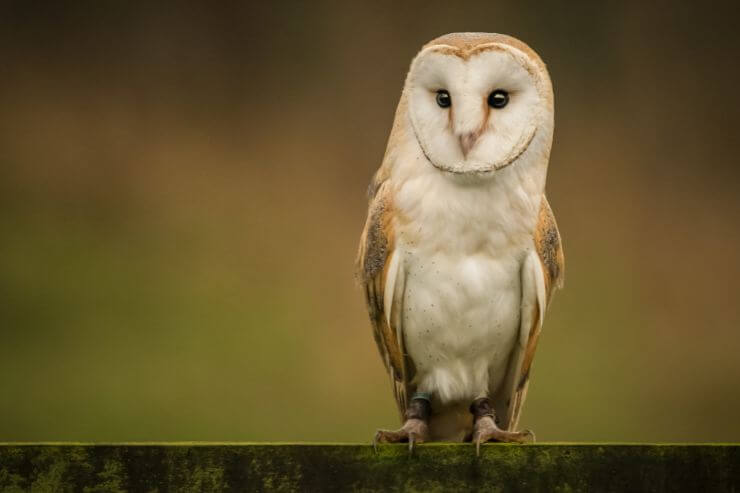
In Nevada’s populated areas, American Barn Owls find crevices within abandoned buildings or natural cavities to lay eggs. Females prepare simple depressions, relying on a bed of regurgitated pellets for cushioning.
They often choose sites away from heavy disturbance, yet still near open fields that benefit hunting. With an appearance that hints at mystery, they slip in and out of these nesting spots under cover of dusk. Both parents remain attentive, ensuring that developing chicks stay protected from predators.
When night falls across Nevada’s valleys, American Barn Owls glide low, scanning for motion among shrubs and grasses. Their sharp hearing pinpoints faint rustlings, allowing precise strikes. They often search near farms or meadows, capturing unsuspecting prey with swift dives. Though primarily active after dark, they may appear at dusk, especially in remote regions. Their silent approach results from adapted feathers, granting an advantage in open landscapes where each squeak or shuffle can be vital.
Historically, American Barn Owls benefited from Nevada’s agricultural zones, where barns and outbuildings offered nesting spots. Over time, modernization replaced older structures, reducing potential roosts.
Wildlife initiatives responded by encouraging farmers to preserve or install nest boxes, promoting stable owl presence. Attitudes shifted as people recognized this species’ role in controlling local rodent populations. Conservationists also recommend minimizing pesticide use, aiding these sensitive birds.
3. Short-eared Owl
- Scientific name: Asio flammeus
- Life span: 12 years
- Size: 34 to 43 cm (13 to 17 in)
- Weight: 206 to 475 g (7.3 to 16.8 oz)
- Wingspan: 85 to 110 cm (33 to 43 in)
- Status: Least Concern
- State status: Migratory and rare
- Migratory behaviour: Migrates south in winter, leaves late fall.
Short-eared Owls inhabit open landscapes around the globe, favouring grasslands, marshes, and tundra. Their round facial disk features yellow eyes set against dusky feathers, giving them a curious expression. Subtle ear tufts, rarely raised, can be difficult to spot.
Overall plumage appears streaky, blending tones of brown, buff, and white. In flight, broad wings reveal distinct black “wrist” marks. They frequently fly low, with buoyant wingbeats that complement their open-country lifestyle. Often active by day, they remain captivating to watch.
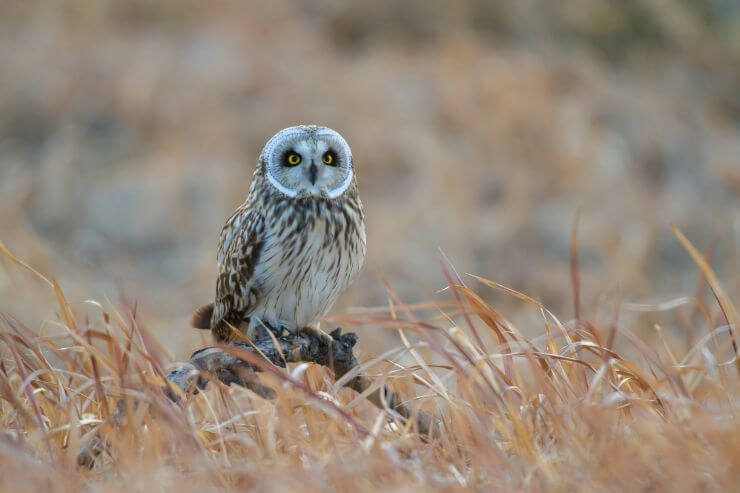
In the expansive grasslands and desert flats of Nevada, Short-eared Owls build ground nests among sparse vegetation. The female scrapes a shallow depression, adding dried grasses for modest warmth.
Because this species favours open terrain, its nesting spots can be susceptible to disturbance, yet it thrives when undisturbed meadows remain intact. Courtship displays often occur during low light, revealing graceful flight patterns. When nesting, both parents protect their territory, warding off intruders with aerial maneuvers.
Within Nevada’s open fields, Short-eared Owls scan for movement while soaring just above the ground. Small mammals, particularly rodents darting through brush, form the core of their nightly pursuits. Keen hearing and sharp vision help pinpoint each elusive target, ensuring swift captures. Flying low, they can abruptly drop onto unsuspecting quarry. This tactic conserves energy in sparse terrain, where food may be patchy.
Over the years, Short-eared Owls in Nevada have faced habitat modifications tied to agriculture and development. Early ranchers saw them as helpers for controlling rodent populations, though others viewed them suspiciously.
Modern conservation endeavours highlight preserving open fields and wetlands where these birds thrive. Monitoring programs track trends, guiding protective measures to encourage sustainable land management. Awareness campaigns stress the need for undisturbed nesting sites.
4. Long-eared Owl
- Scientific name: Asio otus
- Life span: 10 to 27 years
- Size: 31 to 40 cm (12 to 16 in)
- Weight: 160 to 435 g (5.6 to 15.3 oz)
- Wingspan: 86 to 102 cm (2ft 10in to 3ft 4in)
- Status: Least Concern
- State status: Breeding and rare
- Migratory behaviour: Partial migration, some leave in late fall.
The Long-eared Owl roams across North America, Europe, and parts of Asia, favoring wooded areas that provide shelter. Its narrow ear tufts stand erect when alert, giving it a watchful appearance. Mottled feathers in shades of brown and buff help it blend seamlessly with tree bark, while the facial disk accentuates its striking orange eyes.
It often chooses dense conifers or thickets for daytime roosts, concealing itself among branches. During nighttime hours, it moves silently, a presence under starlit skies.
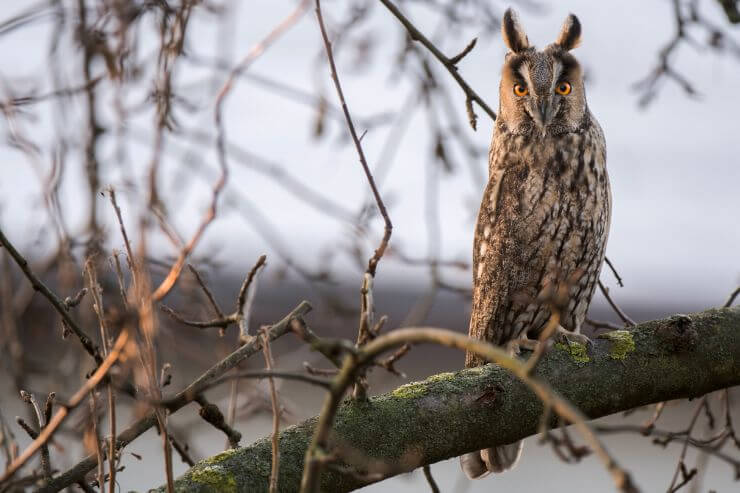
In Nevada, Long-eared Owls pick dense thickets or conifer stands, occasionally reusing stick nests left by magpies or hawks. The female adapts existing structures, adding bark or foliage to cushion the eggs. Concealment proves crucial, as these owls prefer to stay hidden among branches.
Courtship includes gentle hooting calls at quiet twilight, drawing pairs together. Once eggs are laid, the female oversees incubation while the male hunts. Fledglings eventually practice short flights in secluded woodlands.
Stepping into the dusk, Long-eared Owls patrol Nevada’s fields and woodlands with silent determination. Perching methodically, they scan for subtle movements in low vegetation. Once they detect activity, they swoop swiftly, grasping their target in curved talons. This swift approach helps them conserve energy over wide hunting territories. Even faint rustles catch their attention, thanks to keen hearing.
Historically, many Nevadans seldom encountered Long-eared Owls due to their secretive habits. Early ornithologists noted sporadic sightings, prompting curiosity about their ecology. As interest in preserving riparian zones and wooded canyons grew, so did awareness of these elusive birds.
Modern actions include conserving sheltering trees and monitoring breeding sites. Citizen science projects now gather data, guiding habitat management for stable populations.
5. Northern Saw-whet Owl
- Scientific name: Aegolius acadicus
- Life span: 7 to 17 years
- Size: 17 to 22 cm (6.7 to 8.7 in)
- Weight: 54 to 151 g (1.9 to 5.3 oz)
- Wingspan: 42 to 56.3 cm (16.5 to 22.2 in)
- Status: Least Concern
- State status: Breeding and rare
- Migratory behaviour: Some migrate south, leave in late fall.
The Northern Saw-whet Owl inhabits forests across much of North America, in coniferous regions. This tiny owl sports a rounded head and striking golden eyes set against brown plumage marked with white spots. Its facial disk is pale, enclosing an inquisitive expression that belies its secretive nature.
Preferring dense cover, it perches among thick branches by day, remaining unnoticed. At dusk, it becomes active, navigating through moonlit woods. Known for its distinctive calls, it symbolizes hidden wonders in shadowy groves.
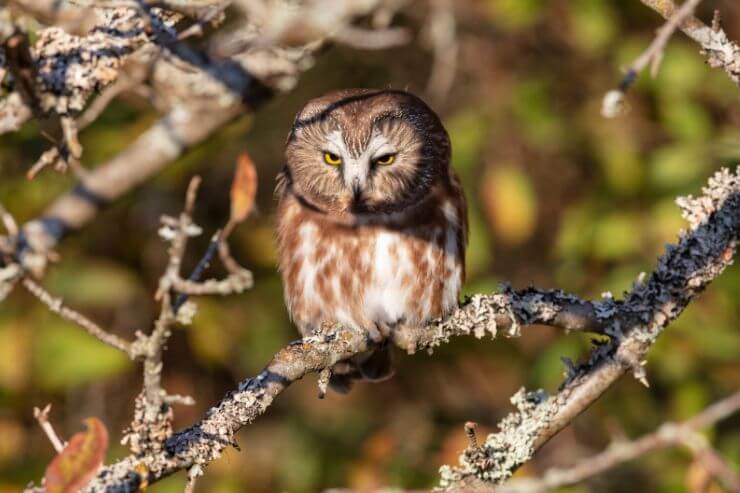
In Nevada’s coniferous woodlands, Northern Saw-whet Owls often utilize abandoned woodpecker cavities for nesting. The female lines these snug hollows with soft material, providing a cozy refuge against chilly mountain nights. Quiet and elusive by day, they remain concealed behind dense foliage.
Courtship involves tooting calls that echo among tall pines, drawing mates closer. Eggs hatch under careful watch, with the mother vigilantly guarding against predators. Once fledged, youngsters disperse across the region’s forested elevations.
After dusk, Northern Saw-whet Owls emerge to prowl Nevada’s wooded slopes, guided by superb hearing. They often perch silently on low branches, scanning for faint movements below. With precision, they drop onto unsuspecting targets, securing them in sharp talons. Even minimal rustling of leaves can alert these hunters. Their nocturnal advantage includes the ability to maneuvers between dense trees.
Traditionally, Northern Saw-whet Owls in Nevada escaped extensive attention due to their secretive habits and high-altitude homes. Early naturalists recorded occasional sightings, leading to greater interest in forest conservation.
Efforts now include monitoring nest sites, preserving mature trees, and ensuring healthy prey populations. Local bird groups share tips for ethical owl-watching, hoping to reduce disturbance in sensitive habitats. As logging practices evolve, maintaining old-growth pockets proves essential.
6. Burrowing Owl
- Scientific name: Athene cunicularia
- Life span: 6-8 years
- Size: 8-11 inches (20-28 cm)
- Weight: 5.3-8.5 oz (150-240 g)
- Wingspan: 20-24 inches (51-61 cm)
- Status: Least Concern
- State status: Breeding and common
- Migratory behaviour: Migrates south in late fall, some stay locally.
Burrowing Owls occupy open landscapes of the Americas, including grasslands, deserts, and agricultural fields. Unlike many owl species, they nest and roost in abandoned burrows, lending them an unusual charm. Their plumage combines earthy tones of brown, buff, and white, with prominent spots on the back and wings.
Large yellow eyes dominate a round head with minimal facial disk. They often stand upright on the ground, surveying surroundings intently. Quick to scuttle or fly, they display alertness across wide stretches.
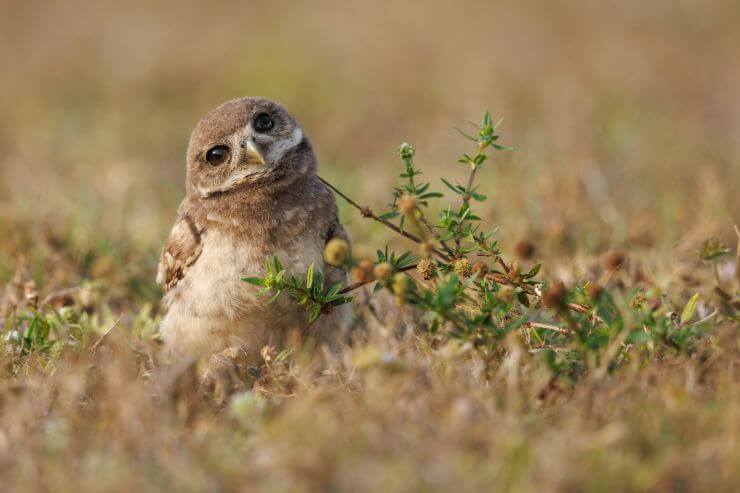
In Nevada’s open deserts and grasslands, Burrowing Owls claim vacated tunnels dug by ground squirrels or other burrowing animals. The female refines the passage with dried plant matter and occasionally lines it with manure, possibly for scent masking.
Both parents remain vigilant near the entrance, scanning for threats across the wide landscape. They show a tolerance for human presence, sometimes nesting near farms or golf courses. Typically, multiple pairs cluster together, sharing prime real estate.
With long legs and a penchant for daytime foraging, Burrowing Owls explore Nevada’s wide horizons in search of sustenance. Perched on fence posts, they swivel their heads to spot even movement. When a target scurries by, they swoop down or sprint across the ground, relying on agility to secure each meal. This flexible approach allows them to exploit various habitats, including edges of agricultural fields.
Over past decades, agricultural expansion and development have removed or disturbed many burrows, affecting Nevada’s Burrowing Owls. Early settlers saw them as oddities on ranch lands, but their beneficial nature in controlling pests gradually gained respect.
Wildlife officials promote habitat protection by preserving open grasslands and reducing pesticide use. Conservation groups also construct artificial burrows, offering safe nesting alternatives. Today, research tracks population health, guiding management actions.
7. Western Screech Owl
- Scientific name: Megascops kennicottii
- Life span: Up to 10 years
- Size: 20-25 cm (8-10 in)
- Weight: 170-230 g (6-8 oz)
- Wingspan: 46-61 cm (18-24 in)
- Status: Least Concern
- State status: Breeding and common
- Migratory behaviour: Stays year-round, does not leave Nevada.
The Western Screech-owl ranges across the western portions of North America, inhabiting woodlands, deserts, and suburban parks. Its compact form is cloaked in camouflage of gray or reddish-brown, marked with streaks and spots that replicate tree bark.
Feathered ear tufts add to its alert demeanour, while the bright yellow eyes stand out against a defined facial disk. Often found in tree cavities, it remains inconspicuous by day. Once darkness falls, its distinctive calls echo through canyons, forests, and neighborhood groves.

In Nevada’s pinyon-juniper woodlands and suburban neighbourhoods, Western Screech-owls quietly establish nests in tree cavities or nest boxes. The female arranges a basic lining of wood chips or feathers, taking advantage of natural hollows created by woodpeckers.
Pairs bond through soft trills and calls before eggs appear. Hidden during daylight, they rely on dappled shade for camouflage. When chicks hatch, both parents guard them, ensuring predators remain at bay until the young can venture out.
When darkness settles on Nevada’s landscapes, Western Screech-owls spring to life, scanning from perches or silently cruising through trees. Their keen eyes and attuned ears detect prey among brush or undergrowth. A swift pounce follows, aided by a wingbeat that allows them to maneuvers in tight spaces. By pausing on strategic lookout points, they minimize wasted effort.
Throughout Nevada, Western Screech-owls have long blended into nocturnal backdrops. Early accounts arose mostly from chance sightings near ranches or waterways, generating interest among residents.
Gradually, communities recognized their presence in city parks and desert oases, sparking conservation measures. Efforts now promote retention of mature trees for nesting cavities and use of pesticides that might eliminate prey. Public education programs highlight these small owls’ role in balancing ecosystems.
8. Northern Pygmy Owl
- Scientific name: Glaucidium californicum
- Life span: Up to 7 years
- Size: 15-18 cm (6-7 in)
- Weight: 57-85 g (2-3 oz)
- Wingspan: 15 inch (38 cm)
- Status: Least Concern
- State status: Breeding and rare
- Migratory behaviour: Stays year-round, no migration from Nevada.
Found largely in coniferous forests of western North America, the Northern Pygmy-owl has a compact silhouette that can be bold. Its plumage features fine spotting on the head and streaks along the breast. The nape displays false eye spots, lending it a distinct look from behind.
A round head with no prominent ear tufts sets it apart. Throughout daylight hours, it may perch conspicuously, scanning surroundings with curious yellow eyes. Despite its diminutive form, it carries an air of confidence.
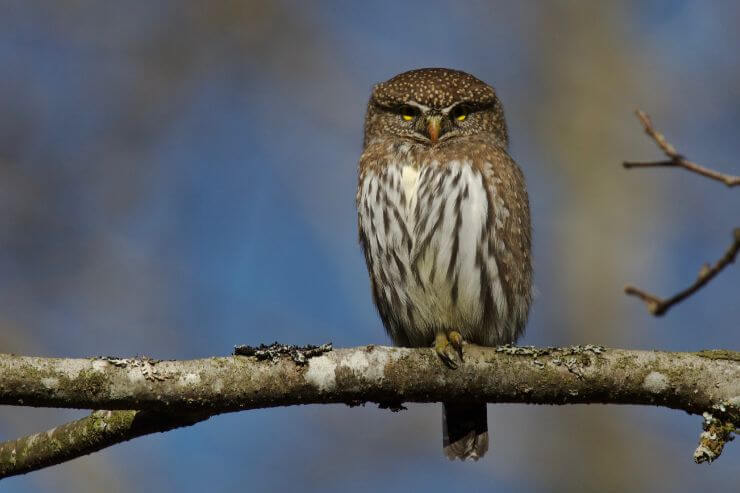
In Nevada’s higher-elevation woodlands, Northern Pygmy-owls occupy old woodpecker holes or natural cavities for nesting. The female lays her eggs on minimal bedding, relying on the cavity’s protection. Courtship begins with whistled notes that reverberate through pine stands, luring potential mates.
Once together, pairs remain attentive to each other’s calls, establishing a territory. These small owls often favor areas near clearings, ensuring flight pathways. Hatchlings stay hidden until strong enough to venture into nearby branches.
Despite their diminutive stature, Northern Pygmy-owls patrol Nevada’s forests with boldness. Perched conspicuously atop snags or branches, they scan for movement below. A swift dive follows, driven by keen eyesight that locks onto unsuspecting quarry.
Even avian species must remain wary, as these owls occasionally target smaller birds. Their hunting style mixes quick bursts of activity with patient observation, ensuring efficiency in terrains.
Historically overlooked due to their size and secretive nature, Northern Pygmy-owls in Nevada garnered attention once ornithologists documented breeding sites. Early records revealed how these resilient birds adapted to shifting forest conditions, prompting studies.
Conservationists now advocate for protecting conifer stands, ensuring enough cavities remain for nesting. Public interest has grown through guided bird walks and citizen science, which gather data on distribution.
9. Flammulated Owl
- Scientific name: Psiloscops flammeolus
- Life span: Up to 8 years
- Size: 15-18 cm (6-7 in)
- Weight: 57-85 g (2-3 oz)
- Wingspan: 38-43 cm (15-17 in)
- Status: Least Concern
- State status: Breeding and rare
- Migratory behaviour: Leaves late summer after breeding, migrates south.
The Flammulated Owl inhabits pine and mixed conifer forests in the mountainous regions of western North America. Named for the flame-like markings on its face, it displays dark eyes encircled by a reddish cast.
Mottled gray and feathers provide camouflage against bark, helping it remain concealed by day. Its compact head lacks ear tufts, though extensions may be raised when alert. Preferring woodland settings, it roosts high in foliage. At dusk, it ventures forth, an elusive dweller under the moon.
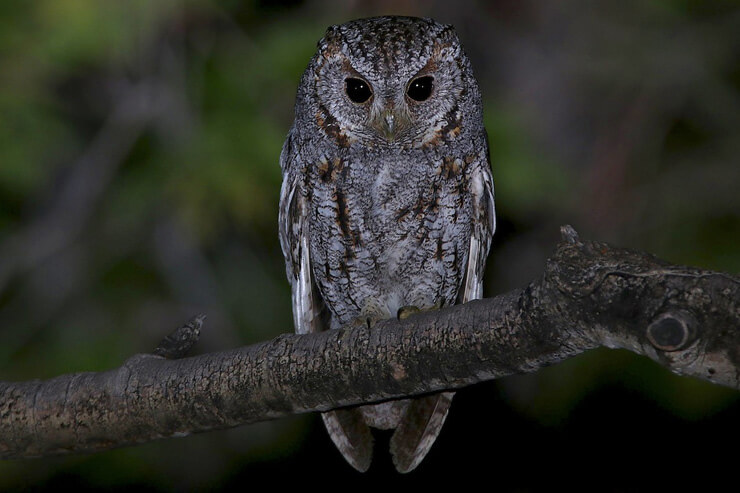
High in Nevada’s ponderosa pine and mixed-conifer forests, Flammulated Owls select natural cavities or old woodpecker holes for laying eggs. The female settles on scant nest material, relying on the trunk’s shelter.
During courtship, males emit low-pitched hoots that echo through evening air, guiding partners to suitable sites. Once eggs are laid, the female remains on duty while the male secures food. Fledglings eventually peek from the hollow entrance, testing formed wings under starlit skies.
Although small, Flammulated Owls navigate Nevada’s nighttime forests with confidence. Their approach to hunting involves observation from mid-level perches, scanning for subtle winged insects passing by. A short glide or quick flutter is all that’s needed to snatch unsuspecting morsels.
Their muted coloration blends against bark, providing an element of surprise. By capitalizing on warm evenings when insect activity peaks, they manage to find consistent meals amid towering pines.
Flammulated Owls in Nevada escaped public notice for years, partly due to their quiet calls and treetop hideaways. Early ornithologists who ventured into remote pine groves reported encounters, encouraging deeper exploration.
Habitat preservation efforts now emphasize mature forests, ensuring a supply of nesting cavities and stable insect populations. Fire management practices also factor in, balancing forest renewal with the needs of sensitive wildlife.
Where to look for Owls in Nevada
Owls in Nevada can be found among desert canyons, mountain woodlands, and wide open plains. If you want to spot them, begin your search at dusk or just before dawn, when they are most active. Move quietly and keep your eyes open for silhouettes perched on fence posts or tree branches. A good tip is to learn their calls beforehand, since hearing a distinctive hoot can guide you to the right spot. Bring a flashlight or headlamp, but use it sparingly to avoid startling them.
One prime location is the Spring Mountains near Las Vegas, where dense pine forests shelter species like Western Screech-owls. Another great spot is the Ruby Mountains in northeastern Nevada, known for its lush valleys that host various owl species.
If you prefer a water setting, head to Lake Mead National Recreation Area, where owls sometimes gather around calm bays. Finally, consider Great Basin National Park with its high-elevation forests offering a chance to glimpse tiny Northern Saw-whet Owls. Wherever you go, remember to respect local wildlife by keeping your distance and minimizing noise.
Patience and preparation are key. Once you catch that first glimpse of an owl, you’ll truly cherish the magical moment forever.
Conclusion
Exploring the diverse landscapes of Nevada in search of owls can reveal a glimpse at these enigmatic nighttime hunters. Whether perched in pine forests or hidden among desert rock formations, owls demonstrate adaptability.
Their presence underscores the importance of conserving habitats that harbour these charismatic raptors. By venturing out at dusk, listening for subtle calls, and practicing mindful observation, enthusiasts can forge lasting connections with these winged wonders. Their awe-inspiring presence enriches Nevada’s wild spirit.


